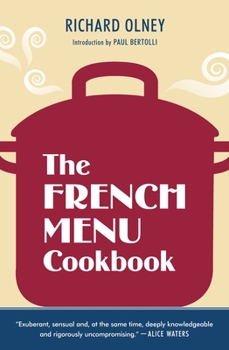The French Menu Cookbook
Select Format
Select Condition 
Book Overview
Customer Reviews
Rated 5 starsBefore there was "Simple French Food"...
Others here have written lengthy and lyrical paeans to this book, so I will try to be brief. It is a masterful book, no doubt about it. Originally published in 1970, "The French Menu Cookbook" reflects a level of sophistication -- and of authentic French sensibility -- that could not be found anywhere else, "Mastering the Art" included, back in the day. Many of the seasonal menus are precisely what one would have at a family...
2Report
Rated 5 starsThis book needs more reviews!
Richard Olney is one of the main voices for French cuisine in the English-speaking world, and yet this book also goes beyond the basics of French cooking and reintroduces to the American public concepts of eating by season and constructing menus based on each dish's impact on the palette, contrasting and matching flavors and textures. In fact, the chapters at the beginning in which Olney simply introduces these ideas, giving...
1Report
Rated 5 starsA great supplement to Simple French Food
This book is a great addition to Olney's classic Simple French Food.
0Report
Rated 5 starsPossibly the most sophisticated cookbook in English
Looking back to 1970, the year this book was first published, puts its sophistications in context and underscores the enormity of its contributions. America was deep in culinary ignorance, eating out of cans and supplementing that metal-tinged blandness with gut-busting mountains of artificial 'foods'. America was lost somehwere between the post-war meat-and-potatoes era and the chemical concoctions of the 80s and beyond...
1Report













